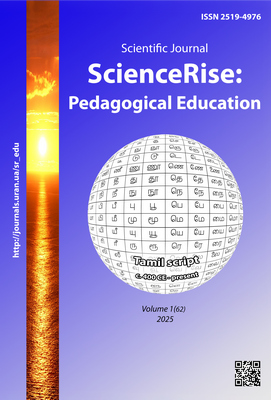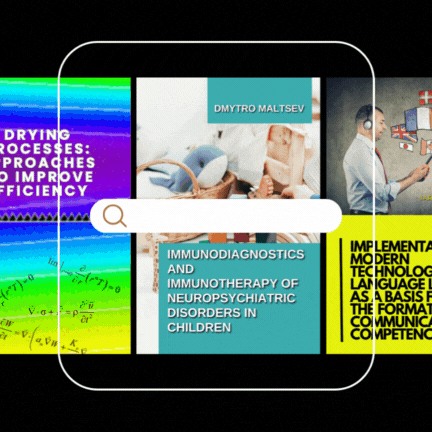Model of forming the readiness of future heads of educational institutions to apply innovative management technologies
DOI:
https://doi.org/10.15587/2519-4984.2025.325941Keywords:
model, structure, content, readiness, leader, innovative management technologies, educational institutionAbstract
The article examines the structure and content of a model for developing the readiness of future heads of educational institutions to apply innovative management technologies. The relevance and importance of developing this model stem from the need to address the contradiction between the current demands of Ukrainian society for future educational leaders who are prepared to apply innovative management technologies and their actual level of readiness for such activities. Resolving this contradiction requires the development and theoretical substantiation of an appropriate model based on updated content, technologies, improved forms and methods, and pedagogical conditions that ensure the formation of such readiness.
We consider the model for developing the readiness of future heads of educational institutions to apply innovative management technologies to be a holistic, complex, and multifaceted pedagogical system that cannot be studied directly. Therefore, it must be investigated through the development of an appropriate model. The design and theoretical substantiation of this model will optimize the process of preparing future educational leaders to apply innovative management technologies.
We believe that the readiness of future heads of educational institutions to apply innovative management technologies aligns with the activity-based approach. Firstly, future leaders must have a comprehensive understanding of management activities, including their functions, content, technologies, forms, and methods. The acquisition and application of these technologies in management activities are possible only if they have clarified the essence of innovative management technologies and the specifics of building relationships among participants in the educational process. Secondly, a future educational leader must understand the management object and the characteristics of all participants in the educational process.
We consider it appropriate to develop the readiness of future heads of educational institutions to apply innovative management technologies during professional training, as professional training is a process, while readiness is both its goal and its outcome. Therefore, the formation of this readiness should be carried out based on a well-developed and theoretically grounded model, which ensures the achievement of the intended results
References
- Maslov, V. I. (2008). Modeliuvannia u teoretychnii i praktychnii diialnosti v pedahohitsi. Pisliadyplomna osvita v Ukraini, 1, 3–9.
- Iarmachenka, M. D. (Ed.) (2001). Pedahohichnyi slovnyk. Kyiv: Pedahohichna dumka, 516.
- Lodatko, Ye. O. (2010). Modeliuvannia pedahohichnykh system i protsesiv. Sloviansk: SDPU, 148.
- Lazarievm, M. I., Ruban, N. P., Lazarieva, T. A. (2009). Teoretychni ta metodychni zasady kreatyvnoho navchannia studentiv tekhnichnykh dystsyplin. Kharkiv – Horlivka: Vyd-vo «LIKhTAR», 112.
- Meshchaninov, O. P. Suchasni modeli rozvytku universytetskoi osvity v Ukraini: teoriia i metodyka. [Extended abstract of Doctors dissertation; In-t pedahohiky i psykholohii prof. osvity APN Ukrainy].
- Ielnykova, H. V., Zaichenko, O. I., Maslov, V. I. et al.; Yelnykova, H. V. (Ed.) (2010). Teoretychni i metodychni zasady modeliuvannia fakhovoi kompetentnosti kerivnykiv zakladiv osvity. Kyiv-Chernivtsi: Knyhy – XXI, 460.
- Melnyk, S. V. (2006). Modeliuvannia diialnosti innovatsiinoho navchalnoho zakladu – Shkoly spryiannia zdoroviu. Ridna shkola, 4, 25–29.
- Shvardak, M. V., Moryliak, S. (2020). Formuvannia hotovnosti maibutnikh kerivnykiv zakladiv osvity do vprovadzhennia innovatsiinykh tekhnolohii. Impact of modernity on science and practice, 658–661. Available at: http://dspace-s.msu.edu.ua:8080/bitstream/123456789/7244/1/Formation%20_of_%20readiness_%20of%20_future_%20heads%20_of_%20educational%20_institutions_%20for_%20introduction%20_of_%20innovative%20_technologies.pdf
- Mykhailyshyn, H., Kondur, O. (2019). Pedahohichne modeliuvannia profesiinoi pidhotovky upravlintsiv z yakosti osvity. Osvitnii prostir Ukrainy, 15, 96–104.
- Voznyuk, A., Kubitskyi, S., Balanovska, T., Chip, L., Dorofyeyev, O. (2022). Synergetic simulation of managing processes in educational sphere in the contest of temporary self-ruled managerial target teams application. Financial and Credit Activity Problems of Theory and Practice, 3 (44), 317–327. https://doi.org/10.55643/fcaptp.3.44.2022.3749
- Isychko, L., Guryevska, O. (2023). Modeling method as a way of information-analytical competence formation in the study of physics. Academic Notes Series Pedagogical Science, 1 (208), 117–124. https://doi.org/10.36550/2415-7988-2023-1-208-117-124
- Honcharenko, S. U. (2008). Pedahohichni doslidzhennia: metodolohichni porady molodym naukovtsiam. Kyiv-Vinnytsia: DOV «Vinnytsia», 278.
- Dym, C. (2004). Principles of mathematical modeling. NewYork: Academic Press, 303. https://doi.org/10.1016/b978-0-12-226551-8.x5000-5
- Montévil, M. (2019). Which first principles for mathematical modeling in biology? Rendiconti di Matematica e dellesue Applicazioni, 40 (3-4), 177–189.
- Rees, M. (2018). Principles of Financial Modeling: Model Design and Best Practices Using Excel and VBA (The Wiley Finance Series). Wiley.
- Honcharenko, S. U. (2012). Pedahohichni zakony, zakonomirnosti, pryntsypy. Suchasne tlumachennia. Rivne: Volyn. Oberehy, 192.
- Zavhorodnii, S. P. (2017). The development of secondary schoolle adersin the concept of innovative competence in postgraduate education. [Extended abstract of PhD dissertation; Vinnytsk. derzh. pedahoh. un-t imeni Mykhaila Kotsiubynskoho]. Available at: https://vspu.edu.ua/science/dis/des_17_1.pdf Last accessed: 13.02.2025
- Pro zatverdzhennia profesiinoho standartu "Kerivnyk (dyrektor) zakladu zahalnoi serednoi osvity" (2021). Nakaz Minekonomiky No. 568-21. 17.09.2021. Available at: https://mon.gov.ua/static-objects/mon/sites/1/news/2021/09/22/Nakaz-568-zatverdzh.standartu.keriv.22.09.pdf Last accessed: 14.02.2025
- Onats, O. (2018). Innovative technologies in the managerial activity of the head of the base educational institution in a textbook for managers. Problemi suchasnogo pіdruchnika, 20, 287–290.
Downloads
Published
How to Cite
Issue
Section
License
Copyright (c) 2025 Oleksandr Vydyborets

This work is licensed under a Creative Commons Attribution 4.0 International License.
Our journal abides by the Creative Commons CC BY copyright rights and permissions for open access journals.
Authors, who are published in this journal, agree to the following conditions:
1. The authors reserve the right to authorship of the work and pass the first publication right of this work to the journal under the terms of a Creative Commons CC BY, which allows others to freely distribute the published research with the obligatory reference to the authors of the original work and the first publication of the work in this journal.
2. The authors have the right to conclude separate supplement agreements that relate to non-exclusive work distribution in the form in which it has been published by the journal (for example, to upload the work to the online storage of the journal or publish it as part of a monograph), provided that the reference to the first publication of the work in this journal is included.








